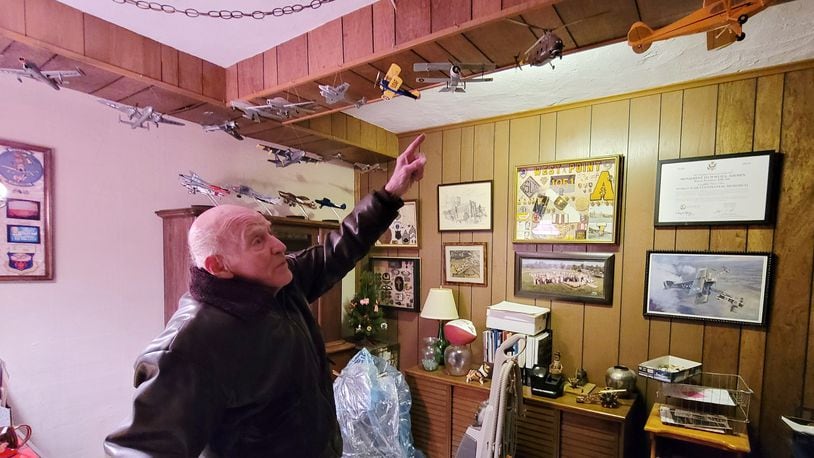But Landry, who now is 92 and living in Hamilton, recently went back further, to a vehicle even older than he is, that was manufactured in Butler County about a century ago. He spent the past year restoring a sulky that was used to train horses how to pull carriages.
Restoration of the two-wheeled, red-and-black cart took lots of care and effort by Landry. He drove into an Amish area of Indiana where he found a carriage manufacturer who knew someone who was able to replicate a complicated axle nut that went missing in about 1969.
Landry’s relationship with the horse cart started when his daughter, Donna, rode horses. The family kept one at the farm of James and Betsy Smith, which was in the area near Maustown in Liberty Twp.
The Smiths gave him the cart, which was rotting in a field, and he stored it in a garage. He planned to put the sulky, with 48-inch-diameter wheels, back together again. But he didn’t take a photo of what it looked like before disassembling it.
“It obviously was not a racing sulky because it was not built for speed, but it was sitting out in the weather, kind of rotting. Part of it was broken,” he said.
Credit: Nick Graham
Credit: Nick Graham
The Landrys used to show the horse, and thought it might pull such a cart. But the cart was in bad shape.
Complicating the repair was the fact one axle nut was lost when the wheels were borrowed for a high school play at Taft High School, where Donna Landry graduated in 1972.
About a year ago, a friend suggested he convert the wooden pieces into a garden bench for the yard. He took another look at it and found at the edge of a seat a little metal tag that said, “Gladys Cart Company, College Corner, Ohio.”
Valerie Elliott, manager of the Smith Library of Regional History at Lane Public Libraries found a 1971 newspaper clipping from the Oxford Press with a photo of the company’s carts.
Such carts were used to train horses to pull carriages, because they’re disconcerted by the sound of rolling wheels right behind them.
With the photo, Landry could figure out how to reassemble the cart. He couldn’t find the axle nut at any hardware store, but a man in Fountain City, Ind., told him he could have someone else “reverse engineer” another one. That was done, and Landry was astounded by the cost of all that work: only $37.
“I’m pretty satisfied with the way things ended up working out,” he said. Only a few pieces of metal and one piece of wood are younger than about 100 years old, he said.
He’s good at creating things. He has built a model of each of the dozens of aircraft he has piloted during his career.
Credit: Nick Graham
Credit: Nick Graham
Landry is a 1951 graduate of West Point. After that, he went to military flying school. He flew sleek F-86 combat Sabrejets in the Korean War, and during the summer of 1956, he flew an F-84 Thunderjet through four atomic bomb clouds and one hydrogen bomb’s aftermath about an hour after bombs were detonated. The plane was equipped to collect radioactive materials about 40,000 feet above the ocean. Well above where he flew, the mushroom clouds were 200 miles wide.
After that, he reached his radioactive exposure limit.
Credit: Nick Graham
Credit: Nick Graham
In late 2019, he attended the commissioning of the USS Cincinnati in Gulfport, Miss. and saw the latest version of his engine design inside the ship. The ship a high-tech detection catamaran that is water-propelled, like a “460-foot-long jet ski,” he said. It doesn’t have propellers. Instead, it uses water pumps for the LM2500 Marine Gas Turbine Engine.
Another Week, Another Recertification! Congrats to the Mighty CINCINNATI on early completion of their Anti-Terrorism...
Posted by USS CINCINNATI (LCS 20) on Thursday, August 27, 2020
He was lead developer for a very similar engine for GE. He retired in 1989.
His next project? A first-hand history of LM2500 engines.
About the Author
